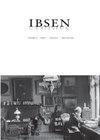Out Of Time: John Gabriel Borkman and the End of Drama
IF 0.1
0 THEATER
引用次数: 0
Abstract
Attending a performance of Henrik Ibsen’s John Gabriel Borkman (1896) directed by Vegard Vinge and Ida M€ uller in Berlin in 2012 required one thing in particular: time. The show, which could last up to twelve hours, often started with a scene that was both simple as well as brilliant: dressed in a devil’s costume, Vinge counted up from one as long as he wanted while the spectators had to endure his tedious and indulgent counting, sometimes for more than an hour before something happened and the stage finally changed. With this beginning the main theme of the performance was firmly set: the experience of time. Vinge’s and M€ uller’s interpretation of John Gabriel Borkman, as radical as it was, seems logical as it takes up a commonplace in Ibsen studies. Since Peter Szondi, who explained the epic tendencies of John Gabriel Borkman as indicative of a crisis of the drama, time has played a decisive role in many other interpretations of the text. These include some interesting approaches that have refined and expanded one of Szondi’s main theses, namely that the analysis of the past fails in the play, since “it is not individual events that stand in the foreground, neither is it their motivation, but time itself” (Szondi and Hays 1983, 201). For instance, Fritz Paul conceives of time as a leitmotif of the text (Paul 1969, 80 ff.); Vigdis Ystad, referring to both Szondi and Paul, identifies “the mythology of time” as the real theme of the text (Ystad 1997, 56); Frode Helland’s investigation concludes without limitation that the play is “characterized by a stiffening of time” (Helland 2000, 303); Eli Park Sørensen shows that the text “explores the time after traditional drama has come to an end”过时:约翰·加布里埃尔·博克曼和戏剧的终结
2012年,在柏林观看由维加德·文奇和艾达·穆勒导演的亨里克·易卜生的《约翰·加布里埃尔·博克曼》(1896)的演出,特别需要一件事:时间。这场长达12个小时的演出通常以一个既简单又精彩的场景开始:文奇穿着魔鬼的服装,从1开始数到他想数多久就数多久,而观众不得不忍受他乏味而放纵的数数,有时要数一个多小时才会有事情发生,舞台最终才会改变。从这个开始,演出的主题就确定下来了:时间的体验。文奇和穆勒对约翰·加布里埃尔·博克曼(John Gabriel Borkman)的解释虽然激进,但在易卜生研究中占据了一个司空见惯的位置,这似乎是合乎逻辑的。自从彼得·桑迪将约翰·加布里埃尔·博克曼的史诗倾向解释为戏剧危机的标志以来,时间在许多其他文本的解释中起着决定性的作用。其中包括一些有趣的方法,这些方法完善和扩展了Szondi的主要论点之一,即对过去的分析在剧中失败了,因为“站在前景中的不是个别事件,也不是它们的动机,而是时间本身”(Szondi和Hays 1983,201)。例如,弗里茨·保罗认为时间是文本的主题(保罗1969,80 ff);Vigdis Ystad提到了Szondi和Paul,将“时间的神话”确定为文本的真正主题(Ystad 1997,56);Frode Helland的调查毫无限制地得出结论,该剧“以时间僵硬为特征”(Helland 2000, 303);Eli Park Sørensen认为文本“探索了传统戏剧走向终结后的时代”。
本文章由计算机程序翻译,如有差异,请以英文原文为准。
求助全文
约1分钟内获得全文
求助全文

 求助内容:
求助内容: 应助结果提醒方式:
应助结果提醒方式:


